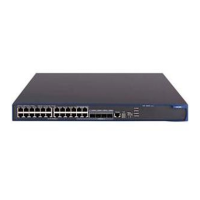5-1
5 CLI Configuration
When configuring CLI, go to these sections for information you are interested in:
z Introduction to the CLI
z Command Hierarchy
z CLI Views
z CLI Features
Introduction to the CLI
A command line interface (CLI) is a user interface to interact with a switch. Through the CLI on a
switch, a user can enter commands to configure the switch and check output information to verify
the configuration. Each S5100-SI/EI series Ethernet switch provides an easy-to-use CLI and a set
of configuration commands for the convenience of the user to configure and manage the switch.
The CLI on S5100-SI/EI series Ethernet switches provides the following features, and so has
good manageability and operability.
z Hierarchical command protection: After users of different levels log in, they can only use
commands at their own, or lower, levels. This prevents users from using unauthorized commands
to configure switches.
z Online help: Users can gain online help at any time by entering a question mark (?).
z Debugging: Abundant and detailed debugging information is provided to help users diagnose and
locate network problems.
z Command history function: This enables users to check the commands that they have lately
executed and re-execute the commands.
z Partial matching of commands: The system will use partially matching method to search for
commands. This allows users to execute a command by entering partially-spelled command
keywords as long as the keywords entered can be uniquely identified by the system.
Command Hierarchy
Command Level and User Privilege Level
Command level
The S5100-SI/EI series Ethernet switches use hierarchical command protection for command
lines, so as to inhibit users at lower levels from using higher-level commands to configure the
switches.
Based on user privilege, commands are classified into four levels, which default to:
z Visit level (level 0): Commands at this level are mainly used to diagnose network, and they cannot
be saved in configuration file. For example, ping, tracert and telnet are level 0 commands.
z Monitor level (level 1): Commands at this level are mainly used to maintain the system and
diagnose service faults, and they cannot be saved in configuration file. Such commands include
debugging and terminal.

